fuel VOLVO S40 2009 Owner´s Manual
[x] Cancel search | Manufacturer: VOLVO, Model Year: 2009, Model line: S40, Model: VOLVO S40 2009Pages: 286, PDF Size: 7.08 MB
Page 6 of 286
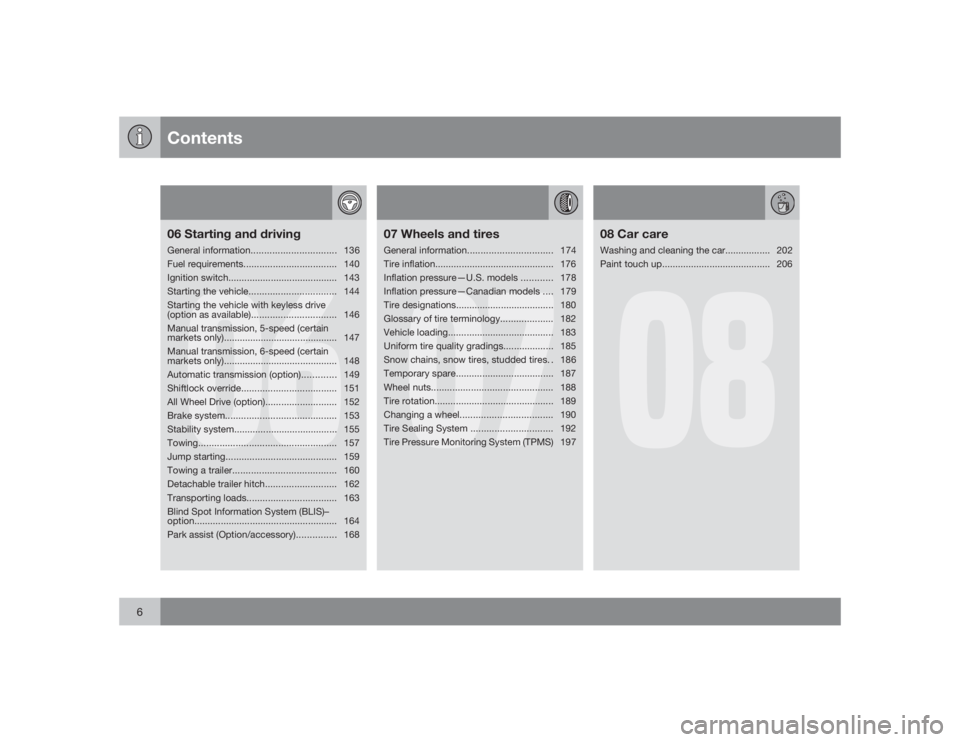
Contents
6
06
06 Starting and drivingGeneral information................................136
Fuel requirements................................... 140
Ignition switch......................................... 143
Starting the vehicle................................. 144
Starting the vehicle with keyless drive
(option as available)................................ 146
Manual transmission, 5-speed (certain
markets only)........................................... 147
Manual transmission, 6-speed (certain
markets only)........................................... 148
Automatic transmission (option)............. 149
Shiftlock override.................................... 151
All Wheel Drive (option)........................... 152
Brake system.......................................... 153
Stability system....................................... 155
Towing.................................................... 157
Jump starting.......................................... 159
Towing a trailer....................................... 160
Detachable trailer hitch........................... 162
Transporting loads.................................. 163
Blind Spot Information System (BLIS)–
option...................................................... 164
Park assist (Option/accessory)............... 168
07
07 Wheels and tiresGeneral information................................174
Tire inflation............................................. 176
Inflation pressure—U.S. models ............ 178
Inflation pressure—Canadian models .... 179
Tire designations..................................... 180
Glossary of tire terminology.................... 182
Vehicle loading........................................ 183
Uniform tire quality gradings................... 185
Snow chains, snow tires, studded tires. . 186
Temporary spare..................................... 187
Wheel nuts.............................................. 188
Tire rotation............................................. 189
Changing a wheel................................... 190
Tire Sealing System ............................... 192
Tire Pressure Monitoring System (TPMS) 197
08
08 Car careWashing and cleaning the car................. 202
Paint touch up......................................... 206
Page 7 of 286
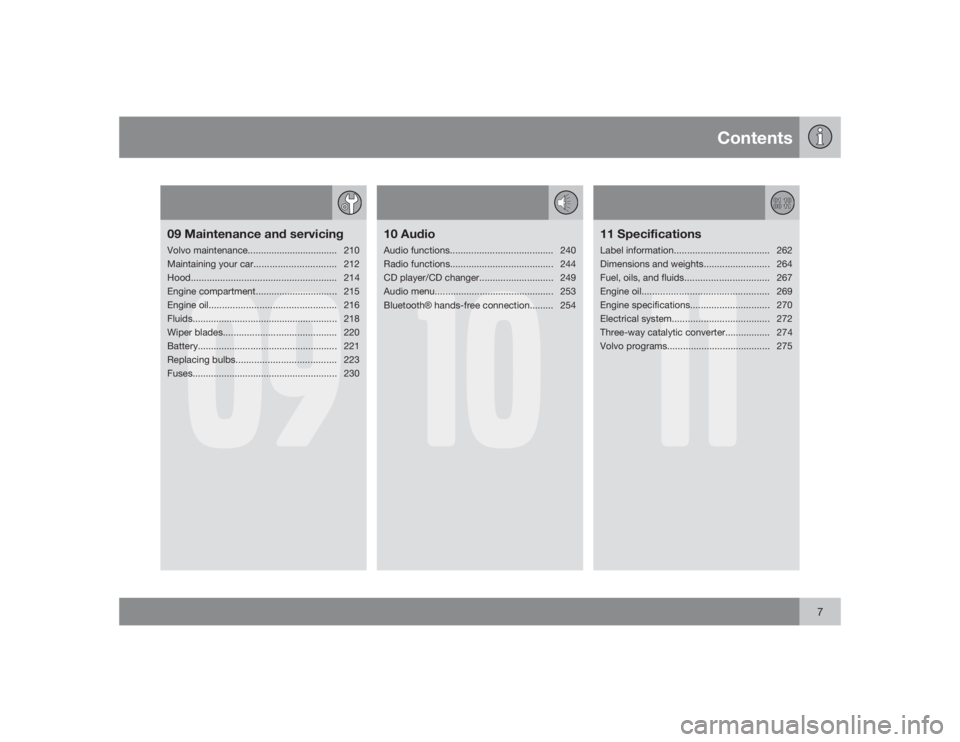
Contents
7
09
09 Maintenance and servicingVolvo maintenance.................................. 210
Maintaining your car............................... 212
Hood.......................................................214
Engine compartment............................... 215
Engine oil................................................ 216
Fluids....................................................... 218
Wiper blades........................................... 220
Battery..................................................... 221
Replacing bulbs...................................... 223
Fuses....................................................... 230
10
10 AudioAudio functions....................................... 240
Radio functions....................................... 244
CD player/CD changer............................ 249
Audio menu............................................. 253
Bluetooth�Ÿ hands-free connection......... 254
11
11 SpecificationsLabel information.................................... 262
Dimensions and weights......................... 264
Fuel, oils, and fluids................................ 267
Engine oil................................................ 269
Engine specifications.............................. 270
Electrical system..................................... 272
Three-way catalytic converter................. 274
Volvo programs....................................... 275
Page 10 of 286
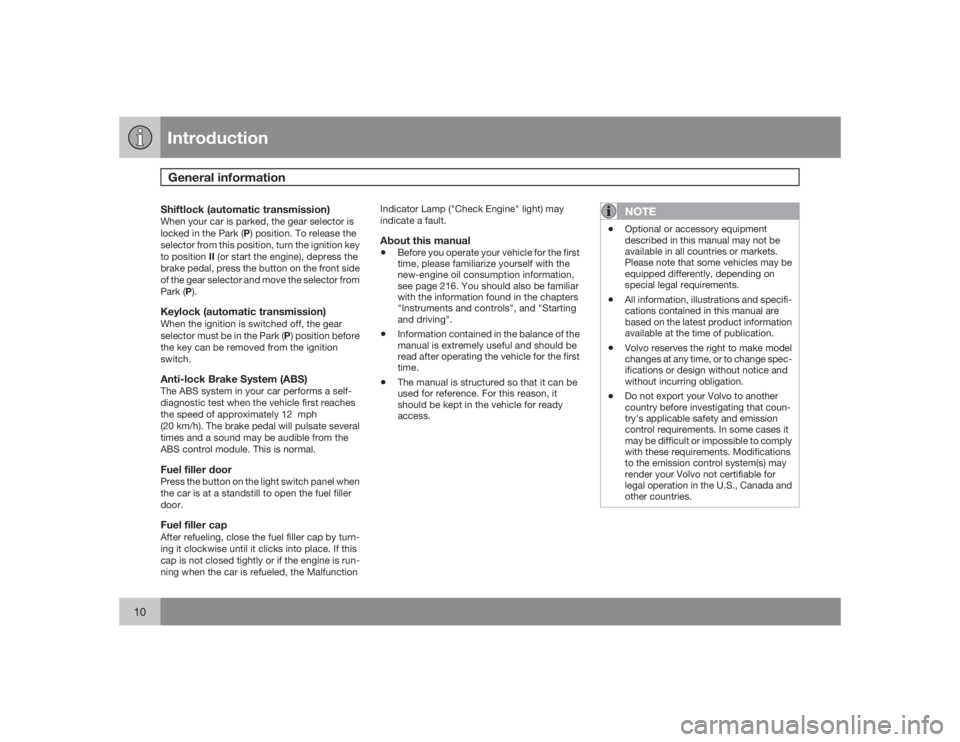
IntroductionGeneral information
10
Shiftlock (automatic transmission)When your car is parked, the gear selector is
locked in the Park (P) position. To release the
selector from this position, turn the ignition key
to position II (or start the engine), depress the
brake pedal, press the button on the front side
of the gear selector and move the selector from
Park (P).Keylock (automatic transmission)When the ignition is switched off, the gear
selector must be in the Park (P) position before
the key can be removed from the ignition
switch.Anti-lock Brake System (ABS)The ABS system in your car performs a self-
diagnostic test when the vehicle first reaches
the speed of approximately 12 mph
(20 km/h). The brake pedal will pulsate several
times and a sound may be audible from the
ABS control module. This is normal.Fuel filler doorPress the button on the light switch panel when
the car is at a standstill to open the fuel filler
door.Fuel filler capAfter refueling, close the fuel filler cap by turn-
ing it clockwise until it clicks into place. If this
cap is not closed tightly or if the engine is run-
ning when the car is refueled, the MalfunctionIndicator Lamp ("Check Engine" light) may
indicate a fault.
About this manual•
Before you operate your vehicle for the first
time, please familiarize yourself with the
new-engine oil consumption information,
see page 216. You should also be familiar
with the information found in the chapters
"Instruments and controls", and "Starting
and driving".
•
Information contained in the balance of the
manual is extremely useful and should be
read after operating the vehicle for the first
time.
•
The manual is structured so that it can be
used for reference. For this reason, it
should be kept in the vehicle for ready
access.
NOTE
•
Optional or accessory equipment
described in this manual may not be
available in all countries or markets.
Please note that some vehicles may be
equipped differently, depending on
special legal requirements.
•
All information, illustrations and specifi-
cations contained in this manual are
based on the latest product information
available at the time of publication.
•
Volvo reserves the right to make model
changes at any time, or to change spec-
ifications or design without notice and
without incurring obligation.
•
Do not export your Volvo to another
country before investigating that coun-
try's applicable safety and emission
control requirements. In some cases it
may be difficult or impossible to comply
with these requirements. Modifications
to the emission control system(s) may
render your Volvo not certifiable for
legal operation in the U.S., Canada and
other countries.
Page 12 of 286
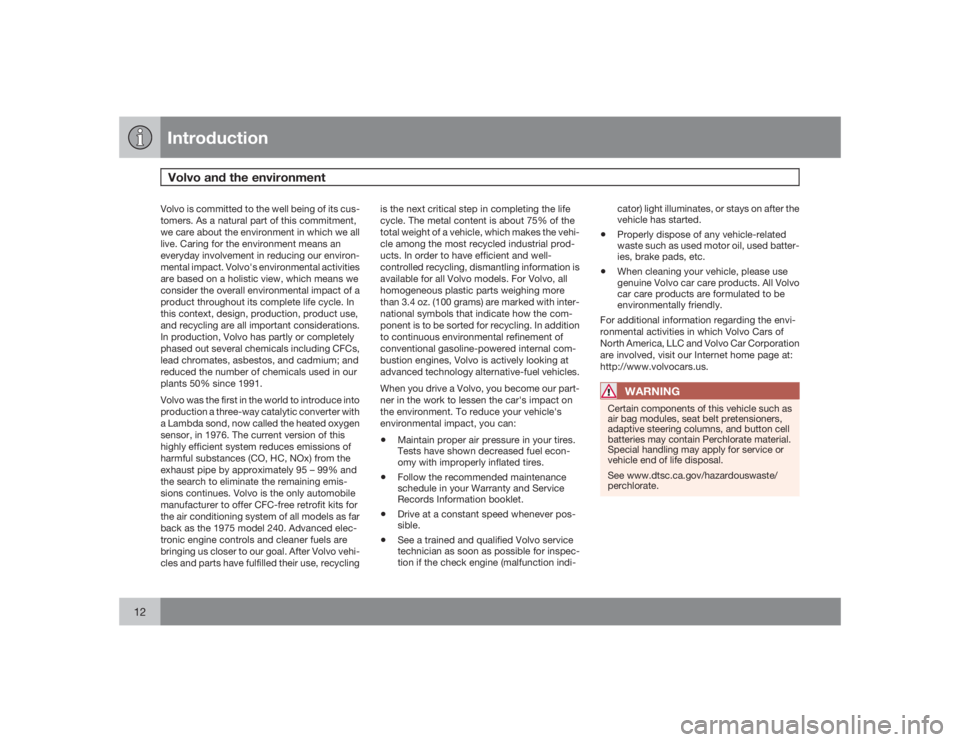
IntroductionVolvo and the environment
12
Volvo is committed to the well being of its cus-
tomers. As a natural part of this commitment,
we care about the environment in which we all
live. Caring for the environment means an
everyday involvement in reducing our environ-
mental impact. Volvo's environmental activities
are based on a holistic view, which means we
consider the overall environmental impact of a
product throughout its complete life cycle. In
this context, design, production, product use,
and recycling are all important considerations.
In production, Volvo has partly or completely
phased out several chemicals including CFCs,
lead chromates, asbestos, and cadmium; and
reduced the number of chemicals used in our
plants 50% since 1991.
Volvo was the first in the world to introduce into
production a three-way catalytic converter with
a Lambda sond, now called the heated oxygen
sensor, in 1976. The current version of this
highly efficient system reduces emissions of
harmful substances (CO, HC, NOx) from the
exhaust pipe by approximately 95 – 99% and
the search to eliminate the remaining emis-
sions continues. Volvo is the only automobile
manufacturer to offer CFC-free retrofit kits for
the air conditioning system of all models as far
back as the 1975 model 240. Advanced elec-
tronic engine controls and cleaner fuels are
bringing us closer to our goal. After Volvo vehi-
cles and parts have fulfilled their use, recyclingis the next critical step in completing the life
cycle. The metal content is about 75% of the
total weight of a vehicle, which makes the vehi-
cle among the most recycled industrial prod-
ucts. In order to have efficient and well-
controlled recycling, dismantling information is
available for all Volvo models. For Volvo, all
homogeneous plastic parts weighing more
than 3.4 oz. (100 grams) are marked with inter-
national symbols that indicate how the com-
ponent is to be sorted for recycling. In addition
to continuous environmental refinement of
conventional gasoline-powered internal com-
bustion engines, Volvo is actively looking at
advanced technology alternative-fuel vehicles.
When you drive a Volvo, you become our part-
ner in the work to lessen the car's impact on
the environment. To reduce your vehicle's
environmental impact, you can:
•
Maintain proper air pressure in your tires.
Tests have shown decreased fuel econ-
omy with improperly inflated tires.
•
Follow the recommended maintenance
schedule in your Warranty and Service
Records Information booklet.
•
Drive at a constant speed whenever pos-
sible.
•
See a trained and qualified Volvo service
technician as soon as possible for inspec-
tion if the check engine (malfunction indi-cator) light illuminates, or stays on after the
vehicle has started.
•
Properly dispose of any vehicle-related
waste such as used motor oil, used batter-
ies, brake pads, etc.
•
When cleaning your vehicle, please use
genuine Volvo car care products. All Volvo
car care products are formulated to be
environmentally friendly.
For additional information regarding the envi-
ronmental activities in which Volvo Cars of
North America, LLC and Volvo Car Corporation
are involved, visit our Internet home page at:
http://www.volvocars.us.WARNING
Certain components of this vehicle such as
air bag modules, seat belt pretensioners,
adaptive steering columns, and button cell
batteries may contain Perchlorate material.
Special handling may apply for service or
vehicle end of life disposal.
See www.dtsc.ca.gov/hazardouswaste/
perchlorate.
Page 34 of 286

01 SafetyCrash mode
0134
Driving after a collision
G026363
If the vehicle has been involved in a collision,
the text
CRASH MODE SEE MANUAL
may
appear in the information display. This indi-
cates that the vehicle's functionality has been
reduced.
This text can only be shown if the display is
undamaged and the vehicle's electrical system
is intact.
CRASH MODE is a feature that is triggered if
one or more of the safety systems (for example,
front or side airbags, an inflatable curtain, or
one or more of the seat belt pretensioners) has
deployed. The collision may have damaged an
important function in the vehicle, such as thefuel lines, sensors for one of the safety sys-
tems, the brake system, etc.
WARNING
•
Never attempt to repair the vehicle
yourself or to reset the electrical system
after the vehicle has displayed
CRASH
MODE SEE MANUAL
. This could
result in injury or improper system func-
tion.
•
Restoring the vehicle to normal operat-
ing mode should only be done by a
trained and qualified Volvo service tech-
nician.
•
After
CRASH MODE SEE MANUAL
has been displayed, if you detect the
odor of fuel vapor, or see any signs of
fuel leakage, do not attempt to start the
vehicle. Leave the vehicle immediately.
Attempting to start the vehicleIf damage to the vehicle is minor and there is
no fuel leakage, you may attempt to start the
vehicle. To do so:
1. Remove the ignition key or optional keyless
drive start control, see page 146.
2. Reinsert the key or start control in the igni-
tion switch. The vehicle will then attempt to
reset CRASH MODE to normal mode.3. Try to start the vehicle.
Moving the vehicleIf the electrical system is able to reset system
status to normal (
CRASH MODE SEE
MANUAL
will no longer be displayed), the
vehicle may be moved carefully from its pres-
ent position, if for example, it is blocking traffic.
It should, however, not be moved farther than
is absolutely necessary.
WARNING
Even if the vehicle appears to be drivable
after CRASH MODE has been set, it should
not be driven or towed (pulled by another
vehicle). There may be concealed damage
that could make it difficult or impossible to
control. The vehicle should be transported
on a flatbed tow truck to a trained and quali-
fied Volvo service technician for inspection/
repairs.
Page 51 of 286
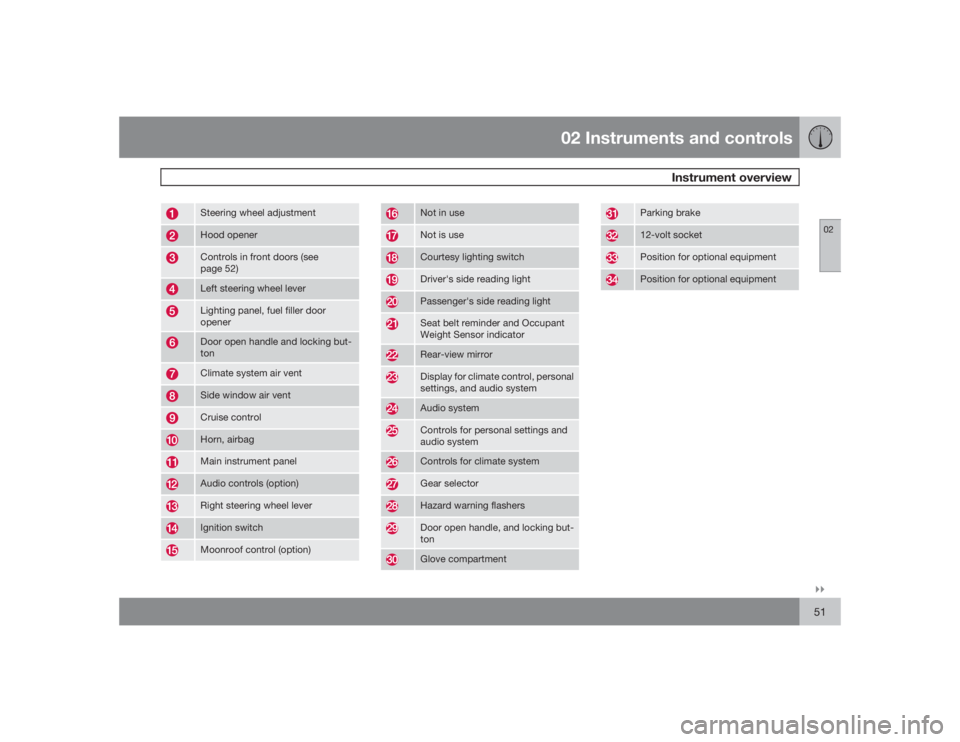
02 Instruments and controls
Instrument overview
02�`�`51
Steering wheel adjustmentHood openerControls in front doors (see
page 52)Left steering wheel leverLighting panel, fuel filler door
openerDoor open handle and locking but-
tonClimate system air ventSide window air ventCruise controlHorn, airbagMain instrument panelAudio controls (option)Right steering wheel leverIgnition switchMoonroof control (option)
Not in useNot is useCourtesy lighting switchDriver's side reading lightPassenger's side reading lightSeat belt reminder and Occupant
Weight Sensor indicatorRear-view mirrorDisplay for climate control, personal
settings, and audio systemAudio systemControls for personal settings and
audio systemControls for climate systemGear selectorHazard warning flashersDoor open handle, and locking but-
tonGlove compartment
Parking brake12-volt socketPosition for optional equipmentPosition for optional equipment
Page 53 of 286
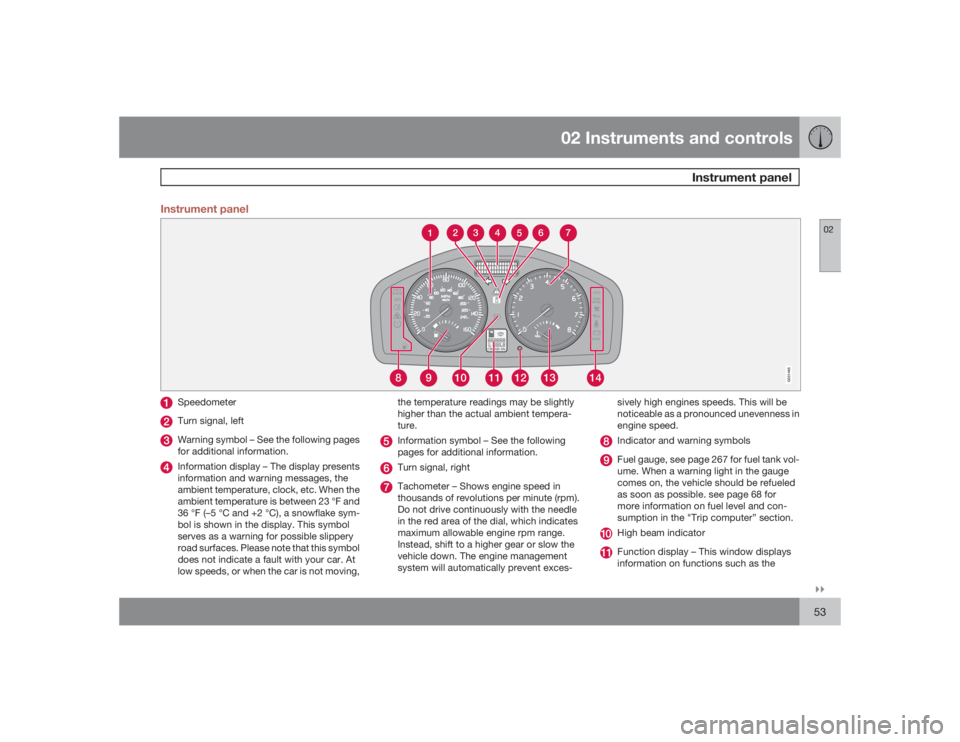
02 Instruments and controls
Instrument panel
02�`�`53 Instrument panel
8
9
11
12
13
14
10
G031465
4 3 2
567
1
SpeedometerTurn signal, leftWarning symbol – See the following pages
for additional information.Information display – The display presents
information and warning messages, the
ambient temperature, clock, etc. When the
ambient temperature is between 23 °F and
36 °F (–5 °C and +2 °C), a snowflake sym-
bol is shown in the display. This symbol
serves as a warning for possible slippery
road surfaces. Please note that this symbol
does not indicate a fault with your car. At
low speeds, or when the car is not moving,the temperature readings may be slightly
higher than the actual ambient tempera-
ture.
Information symbol – See the following
pages for additional information.Turn signal, rightTachometer – Shows engine speed in
thousands of revolutions per minute (rpm).
Do not drive continuously with the needle
in the red area of the dial, which indicates
maximum allowable engine rpm range.
Instead, shift to a higher gear or slow the
vehicle down. The engine management
system will automatically prevent exces-sively high engines speeds. This will be
noticeable as a pronounced unevenness in
engine speed.
Indicator and warning symbolsFuel gauge, see page 267 for fuel tank vol-
ume. When a warning light in the gauge
comes on, the vehicle should be refueled
as soon as possible. see page 68 for
more information on fuel level and con-
sumption in the "Trip computer” section.High beam indicatorFunction display – This window displays
information on functions such as the
Page 57 of 286
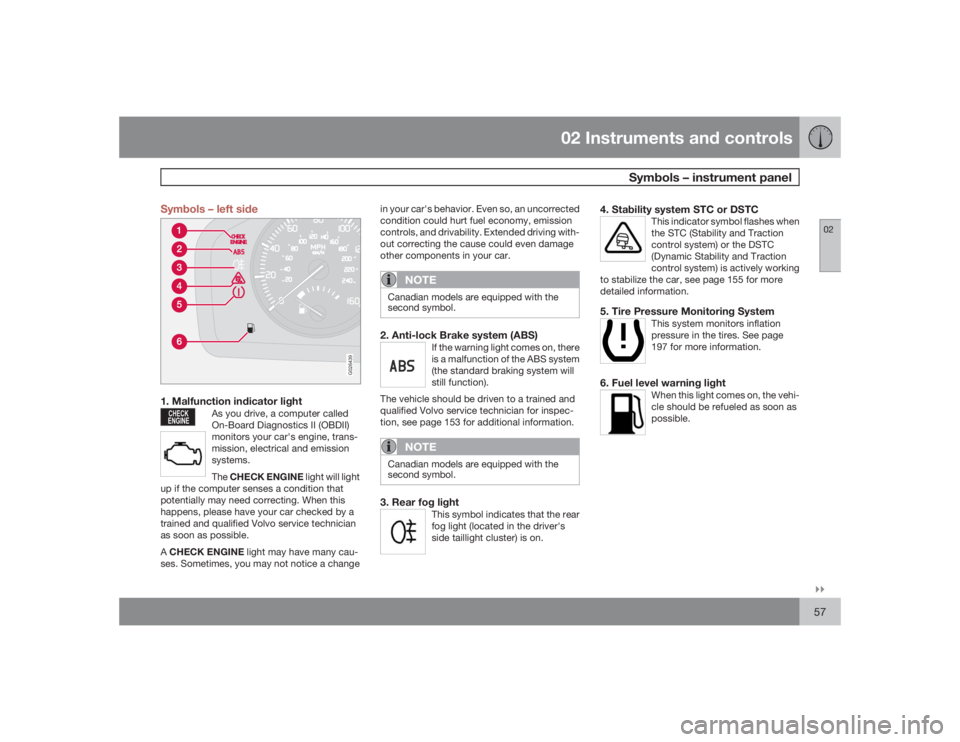
02 Instruments and controls
Symbols – instrument panel
02�`�`57 Symbols – left side
G026439
1. Malfunction indicator light
As you drive, a computer called
On-Board Diagnostics II (OBDII)
monitors your car's engine, trans-
mission, electrical and emission
systems.
TheCHECK ENGINE light will light
up if the computer senses a condition that
potentially may need correcting. When this
happens, please have your car checked by a
trained and qualified Volvo service technician
as soon as possible.
CHECK
ENGINEACHECK ENGINE light may have many cau-
ses. Sometimes, you may not notice a changein your car's behavior. Even so, an uncorrected
condition could hurt fuel economy, emission
controls, and drivability. Extended driving with-
out correcting the cause could even damage
other components in your car.
NOTE
Canadian models are equipped with the
second symbol.2. Anti-lock Brake system (ABS)
If the warning light comes on, there
is a malfunction of the ABS system
(the standard braking system will
still function).
The vehicle should be driven to a trained and
qualified Volvo service technician for inspec-
tion, see page 153 for additional information.
NOTE
Canadian models are equipped with the
second symbol.3. Rear fog light
This symbol indicates that the rear
fog light (located in the driver's
side taillight cluster) is on.
4. Stability system STC or DSTC
This indicator symbol flashes when
the STC (Stability and Traction
control system) or the DSTC
(Dynamic Stability and Traction
control system) is actively working
to stabilize the car, see page 155 for more
detailed information.
5. Tire Pressure Monitoring System
This system monitors inflation
pressure in the tires. See page
197 for more information.
6. Fuel level warning light
When this light comes on, the vehi-
cle should be refueled as soon as
possible.
Page 65 of 286
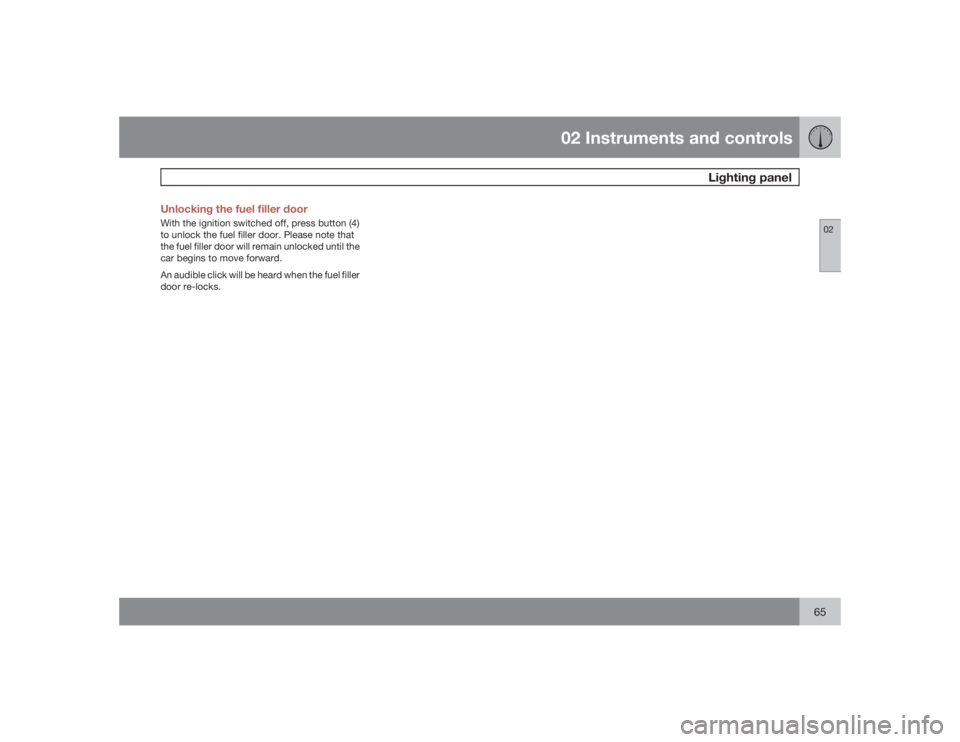
02 Instruments and controls
Lighting panel
0265 Unlocking the fuel filler door
With the ignition switched off, press button (4)
to unlock the fuel filler door. Please note that
the fuel filler door will remain unlocked until the
car begins to move forward.
An audible click will be heard when the fuel filler
door re-locks.
Page 68 of 286
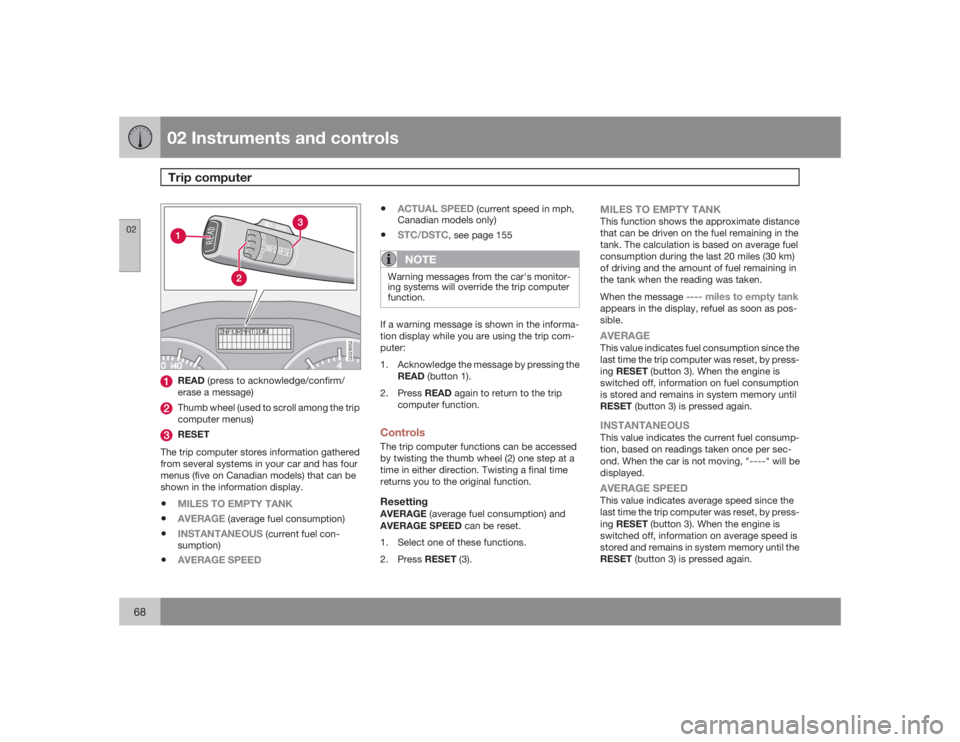
02 Instruments and controlsTrip computer
0268
G029052
READ (press to acknowledge/confirm/
erase a message)Thumb wheel (used to scroll among the trip
computer menus)RESET
The trip computer stores information gathered
from several systems in your car and has four
menus (five on Canadian models) that can be
shown in the information display.
•
MILES TO EMPTY TANK
•
AVERAGE
(average fuel consumption)
•
INSTANTANEOUS
(current fuel con-
sumption)
•
AVERAGE SPEED
•
ACTUAL SPEED
(current speed in mph,
Canadian models only)
•
STC/DSTC
, see page 155
NOTE
Warning messages from the car's monitor-
ing systems will override the trip computer
function.If a warning message is shown in the informa-
tion display while you are using the trip com-
puter:
1. Acknowledge the message by pressing the
READ (button 1).
2.
PressREAD again to return to the trip
computer function.ControlsThe trip computer functions can be accessed
by twisting the thumb wheel (2) one step at a
time in either direction. Twisting a final time
returns you to the original function.ResettingAVERAGE (average fuel consumption) and
AVERAGE SPEED can be reset.
1. Select one of these functions.
2.
PressRESET (3).
MILES TO EMPTY TANKThis function shows the approximate distance
that can be driven on the fuel remaining in the
tank. The calculation is based on average fuel
consumption during the last 20 miles (30 km)
of driving and the amount of fuel remaining in
the tank when the reading was taken.
When the message
---- miles to empty tank
appears in the display, refuel as soon as pos-
sible.AVERAGEThis value indicates fuel consumption since the
last time the trip computer was reset, by press-
ingRESET (button 3). When the engine is
switched off, information on fuel consumption
is stored and remains in system memory until
RESET(button 3) is pressed again.INSTANTANEOUSThis value indicates the current fuel consump-
tion, based on readings taken once per sec-
ond. When the car is not moving, "
----
" will be
displayed.
AVERAGE SPEEDThis value indicates average speed since the
last time the trip computer was reset, by press-
ingRESET (button 3). When the engine is
switched off, information on average speed is
stored and remains in system memory until the
RESET (button 3) is pressed again.